人教六年级小升初英文必背知识点汇总40条
- 格式:doc
- 大小:29.50 KB
- 文档页数:5
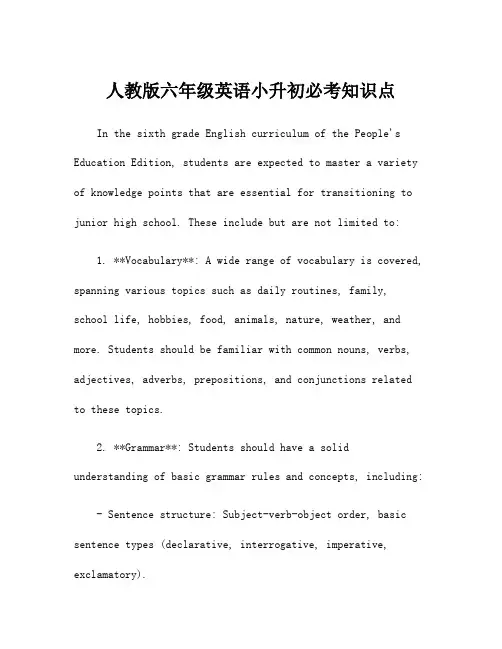
人教版六年级英语小升初必考知识点In the sixth grade English curriculum of the People's Education Edition, students are expected to master a variety of knowledge points that are essential for transitioning to junior high school. These include but are not limited to:1. **Vocabulary**: A wide range of vocabulary is covered, spanning various topics such as daily routines, family, school life, hobbies, food, animals, nature, weather, and more. Students should be familiar with common nouns, verbs, adjectives, adverbs, prepositions, and conjunctions related to these topics.2. **Grammar**: Students should have a solid understanding of basic grammar rules and concepts, including: - Sentence structure: Subject-verb-object order, basic sentence types (declarative, interrogative, imperative, exclamatory).- Parts of speech: Nouns, pronouns, verbs, adjectives, adverbs, prepositions, conjunctions, and interjections.- Verb tenses: Present simple, present continuous, past simple, future with "will."- Pronouns: Personal pronouns (subject and object forms), possessive pronouns, reflexive pronouns.- Articles: Definite and indefinite articles (the, a/an).- Plurals: Regular and irregular plural nouns.- Comparative and superlative forms of adjectives and adverbs.- Modal verbs: Can, could, may, might, must, shall, should, will, would.- Simple future tense with "be going to."- Reported speech: Statements, questions, commands, and requests.- Conditional sentences: Zero, first, and second conditionals.- Passive voice: Present and past passive forms.3. **Reading Comprehension**: Students are expected to understand and interpret various types of texts, including narratives, dialogues, informational passages, and poems. They should be able to:- Identify main ideas and supporting details.- Make predictions based on context clues.- Infer the meaning of unfamiliar words.- Recognize literary devices such as similes, metaphors, personification, and onomatopoeia.- Summarize texts and identify the author's purpose.4. **Writing Skills**: Students should be able to express themselves effectively in writing, demonstrating:- Proper sentence structure and punctuation.- Clear organization of ideas into paragraphs.- Use of transition words and phrases to connect ideas.- Descriptive language to create vivid imagery.- Writing various types of texts, including narratives, descriptions, recounts, letters, and instructions.- Proofreading and editing skills to improve the clarity and coherence of their writing.5. **Listening and Speaking**: Students should be able to listen to and understand spoken English in different contexts, such as classroom instructions, conversations, stories, and presentations. They should also be able to communicate orally by:- Asking and answering questions.- Participating in discussions and role-plays.- Giving presentations on familiar topics.- Following multi-step instructions.- Pronouncing words and phrases accurately.6. **Cultural Awareness**: While primarily focused on language skills, the curriculum may also include aspects of cultural awareness, such as learning about English-speaking countries, their customs, traditions, and holidays.Overall, mastery of these knowledge points prepares students for success in junior high school and lays a solid foundation for further English language learning.。
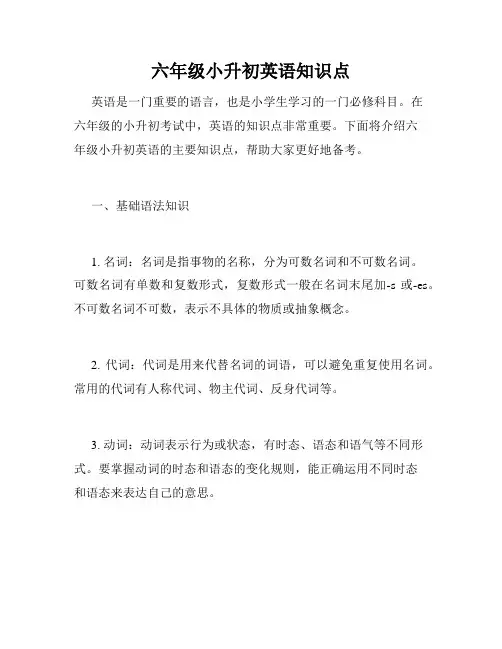
六年级小升初英语知识点英语是一门重要的语言,也是小学生学习的一门必修科目。
在六年级的小升初考试中,英语的知识点非常重要。
下面将介绍六年级小升初英语的主要知识点,帮助大家更好地备考。
一、基础语法知识1. 名词:名词是指事物的名称,分为可数名词和不可数名词。
可数名词有单数和复数形式,复数形式一般在名词末尾加-s或-es。
不可数名词不可数,表示不具体的物质或抽象概念。
2. 代词:代词是用来代替名词的词语,可以避免重复使用名词。
常用的代词有人称代词、物主代词、反身代词等。
3. 动词:动词表示行为或状态,有时态、语态和语气等不同形式。
要掌握动词的时态和语态的变化规则,能正确运用不同时态和语态来表达自己的意思。
4. 形容词和副词:形容词用来描述事物的特征或性质,副词则用来修饰动词、形容词或其他副词。
要注意形容词和副词的比较级和最高级形式的变化。
5. 介词:介词用来表示时间、地点、原因等关系,常常与名词或代词连用。
要掌握常用的介词及其搭配的用法。
二、阅读理解阅读理解是考察学生对英语文章的理解和推理能力的重要环节,主要包括词义理解、推断、主旨概括等方面。
1. 词义理解:通过上下文推断单词或短语的意思,掌握常用词汇的词义和用法。
2. 推断:根据文章中的信息进行推理,理解文章的逻辑结构和意义。
3. 主旨概括:概括文章的主要内容和中心思想,突出文章的重点和要义。
三、听力技巧在小升初英语考试中,听力是一个重要的考查内容。
要提高听力能力,需要掌握一些听力技巧。
1. 注意听力指令:仔细听题目要求,明确问题的要求。
2. 注意听力材料的关键信息:听力材料中会包含一些关键信息,比如数字、时间、地点等,要注意识别并记忆这些信息。
3. 掌握常见的听力形式:考试中常见的听力形式有听对话回答问题、听短文选择答案、听对话填空等,要熟悉这些形式,并掌握相应的解题技巧。
四、口语表达口语表达是英语学习的重要部分,也是小升初英语考试的一项内容。
要提高口语表达能力,可以进行一些口语练习和交流。
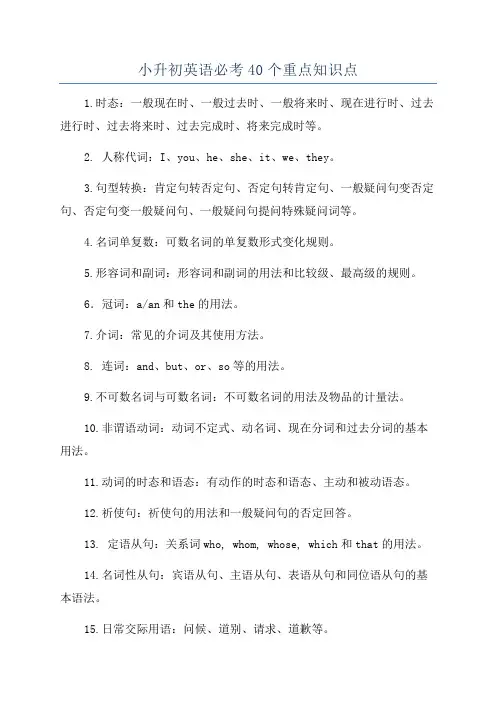
小升初英语必考40个重点知识点1.时态:一般现在时、一般过去时、一般将来时、现在进行时、过去进行时、过去将来时、过去完成时、将来完成时等。
2. 人称代词:I、you、he、she、it、we、they。
3.句型转换:肯定句转否定句、否定句转肯定句、一般疑问句变否定句、否定句变一般疑问句、一般疑问句提问特殊疑问词等。
4.名词单复数:可数名词的单复数形式变化规则。
5.形容词和副词:形容词和副词的用法和比较级、最高级的规则。
6.冠词:a/an和the的用法。
7.介词:常见的介词及其使用方法。
8. 连词:and、but、or、so等的用法。
9.不可数名词与可数名词:不可数名词的用法及物品的计量法。
10.非谓语动词:动词不定式、动名词、现在分词和过去分词的基本用法。
11.动词的时态和语态:有动作的时态和语态、主动和被动语态。
12.祈使句:祈使句的用法和一般疑问句的否定回答。
13. 定语从句:关系词who, whom, whose, which和that的用法。
14.名词性从句:宾语从句、主语从句、表语从句和同位语从句的基本语法。
15.日常交际用语:问候、道别、请求、道歉等。
16.宾语:及物动词后面的宾语和介词后面的宾语。
17.数词:数字和序数词的用法。
18.频率副词:频率副词的位置和用法。
19. 情态动词:can、could、may、might等的用法。
20.反意疑问句:反意疑问句的构成和回答方式。
21.祈使句和陈述句的句型转换。
22.简单句和复合句的句型转换。
23.状语从句:时间、地点、方式等状语从句的用法。
24.英语字母和大小写的用法规则。
25.数字和时间的表达方法。
26.祈使句、感叹句和陈述句的区别。
27.人称代词和形容词性物主代词的用法。
28.祈使句的否定形式的构成和用法。
29.独立主格结构:独立主格结构的基本句型和用法。
30.定语从句和名词性从句的结构和区别。
31.特殊疑问句:特殊疑问句的基本用法和回答方式。
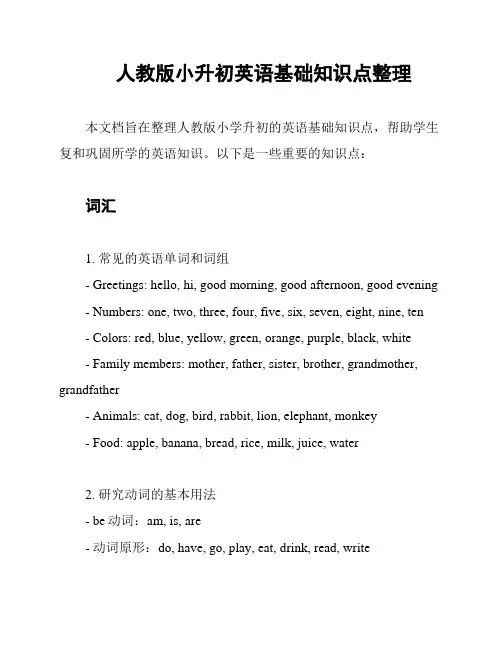
人教版小升初英语基础知识点整理本文档旨在整理人教版小学升初的英语基础知识点,帮助学生复和巩固所学的英语知识。
以下是一些重要的知识点:词汇1. 常见的英语单词和词组- Greetings: hello, hi, good morning, good afternoon, good evening - Numbers: one, two, three, four, five, six, seven, eight, nine, ten- Colors: red, blue, yellow, green, orange, purple, black, white- Family members: mother, father, sister, brother, grandmother, grandfather- Animals: cat, dog, bird, rabbit, lion, elephant, monkey- Food: apple, banana, bread, rice, milk, juice, water2. 研究动词的基本用法- be动词:am, is, are- 动词原形:do, have, go, play, eat, drink, read, write句型和语法1. 简单句的构成- 主语 + 谓语 + 宾语- 例如:I like apples.2. 一般疑问句的构成- 助动词 + 主语 + 谓语- 例如:Do you have a pet?3. yes/no问答和否定句的回答- 是:Yes, + 主语(或代词)- 不是:No, + 主语(或代词)+ 不(否定词)+ 谓语- 例如:- Does he like ice cream? - Yes, he does.- Do you not like pizza? - No, I don't.阅读理解1. 阅读文章并回答问题- 给出简短的文章,要求学生阅读并回答与文章相关的问题。
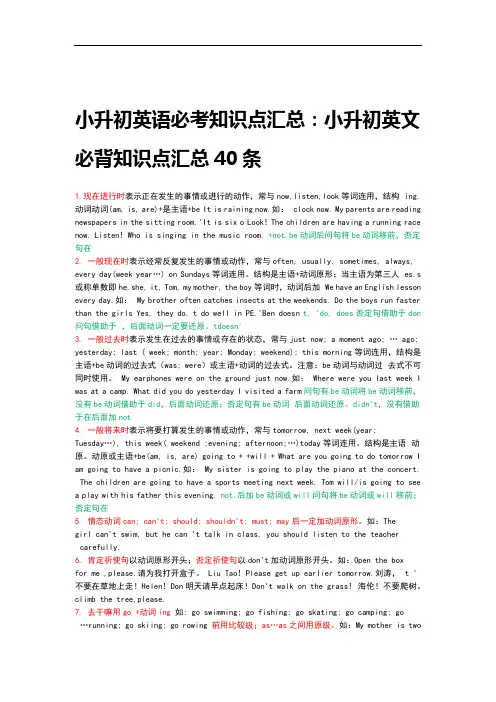
小升初英语必考知识点汇总:小升初英文必背知识点汇总40条1.现在进行时表示正在发生的事情或进行的动作,常与now,listen,look等词连用,结构ing.动词动词(am, is, are)+是主语+be It is raining now.如:clock now. My parents are reading newspapers in the sitting room.'It is six o Look! The children are having a running race now.Listen! Who is singing in the music room.+not.be动词后问句将be动词移前,否定句在2. 一般现在时表示经常反复发生的事情或动作,常与often, usually, sometimes, always, every day(week year…) on Sundays等词连用。
结构是主语+动词原形;当主语为第三人es.s 或称单数即he,she, it, Tom, my mother, the boy等词时,动词后加We have an English lesson every day.如:My brother often catches insects at the weekends.Do the boys run faster than the girls Yes, they do.t do well in PE.'Ben doesn t, 'do, does否定句借助于don 问句借助于,后面动词一定要还原。
tdoesn'3. 一般过去时表示发生在过去的事情或存在的状态,常与just now; a moment ago; … ago; yesterday; last ( week; month; year; Monday; weekend); this morning等词连用,结构是主语+be动词的过去式(was; were)或主语+动词的过去式。
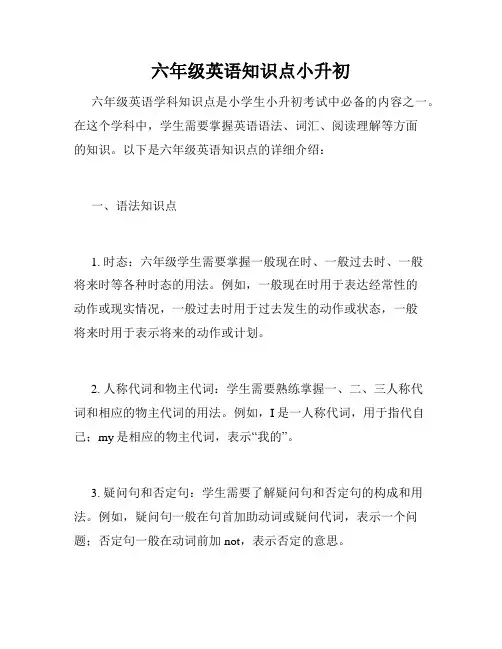
六年级英语知识点小升初六年级英语学科知识点是小学生小升初考试中必备的内容之一。
在这个学科中,学生需要掌握英语语法、词汇、阅读理解等方面的知识。
以下是六年级英语知识点的详细介绍:一、语法知识点1. 时态:六年级学生需要掌握一般现在时、一般过去时、一般将来时等各种时态的用法。
例如,一般现在时用于表达经常性的动作或现实情况,一般过去时用于过去发生的动作或状态,一般将来时用于表示将来的动作或计划。
2. 人称代词和物主代词:学生需要熟练掌握一、二、三人称代词和相应的物主代词的用法。
例如,I是一人称代词,用于指代自己;my是相应的物主代词,表示“我的”。
3. 疑问句和否定句:学生需要了解疑问句和否定句的构成和用法。
例如,疑问句一般在句首加助动词或疑问代词,表示一个问题;否定句一般在动词前加not,表示否定的意思。
4. 比较级和最高级:学生需要学会比较级和最高级的构成和比较等级的用法。
例如,比较级用于比较两个人或事物的特征,最高级用于比较三个或三个以上的人或事物。
二、词汇知识点1. 常用词汇:学生需要掌握一些常用的英语词汇,如动物、植物、食物、颜色、数字、家庭成员、学校用品等。
通过记忆和练习,学生可以提高对词汇的记忆和理解能力。
2. 动词短语:学生需要学习一些常用的动词短语,如go to school(去上学)、have breakfast(吃早餐)、play basketball(打篮球)等。
这些短语在口语和书面语中都有广泛的应用。
三、阅读理解知识点1. 阅读材料:学生需要通过阅读各种类型的文章,如故事、新闻、广告等,提高阅读理解能力。
通过阅读,学生可以了解不同的事物和情况,并从中获取相关信息。
2. 理解问题:学生需要学会阅读文章后回答问题的技巧。
他们需要仔细阅读每个问题,并从文章中找到相关的信息。
通过练习,学生可以提高问题解答的能力。
以上是六年级英语知识点的简要介绍。
学生可以通过课堂上的学习和课后的练习来巩固和提高自己的英语水平。
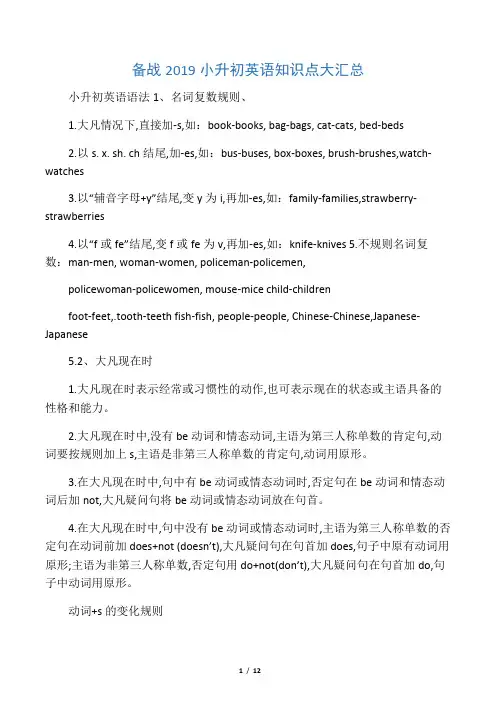
备战2019小升初英语知识点大汇总小升初英语语法1、名词复数规则、1.大凡情况下,直接加-s,如:book-books, bag-bags, cat-cats, bed-beds2.以s. x. sh. ch结尾,加-es,如:bus-buses, box-boxes, brush-brushes,watch-watches3.以“辅音字母+y”结尾,变y为i,再加-es,如:family-families,strawberry-strawberries4.以“f或fe”结尾,变f或fe为v,再加-es,如:knife-knives5.不规则名词复数:man-men, woman-women, policeman-policemen,policewoman-policewomen, mouse-mice child-childrenfoot-feet,.tooth-teeth fish-fish, people-people, Chinese-Chinese,Japanese-Japanese5.2、大凡现在时1.大凡现在时表示经常或习惯性的动作,也可表示现在的状态或主语具备的性格和能力。
2.大凡现在时中,没有be动词和情态动词,主语为第三人称单数的肯定句,动词要按规则加上s,主语是非第三人称单数的肯定句,动词用原形。
3.在大凡现在时中,句中有be动词或情态动词时,否定句在be动词和情态动词后加not,大凡疑问句将be动词或情态动词放在句首。
4.在大凡现在时中,句中没有be动词或情态动词时,主语为第三人称单数的否定句在动词前加does+not (doesn’t),大凡疑问句在句首加does,句子中原有动词用原形;主语为非第三人称单数,否定句用do+not(don’t),大凡疑问句在句首加do,句子中动词用原形。
动词+s的变化规则1.大凡情况下,直接加-s,如:cook-cooks, milk-milks2 .以s. x. sh. ch. o结尾,加-es,如:guess-guesses, wash-washes,watch-watches, go-goes3.以“辅音字母+y”结尾,变y为i,再加-es,如:study-studies3、现在进行时1.现在进行时表示现在正在进行或发生的动作,也可表示当前一段时间内的活动或现阶段正在进行的动作。
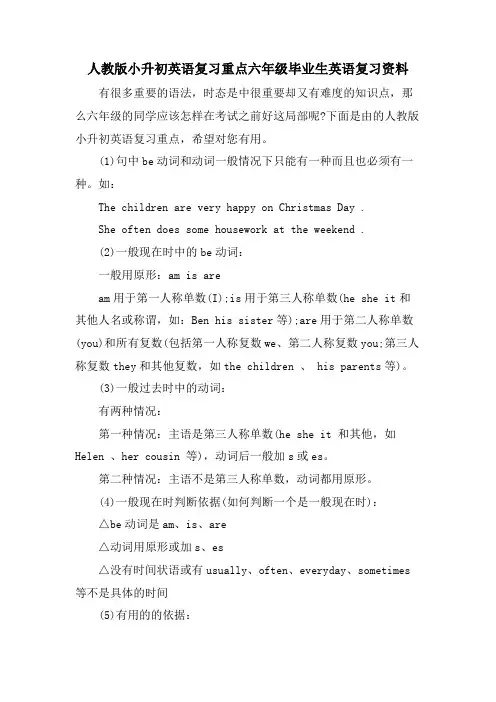
人教版小升初英语复习重点六年级毕业生英语复习资料有很多重要的语法,时态是中很重要却又有难度的知识点,那么六年级的同学应该怎样在考试之前好这局部呢?下面是由的人教版小升初英语复习重点,希望对您有用。
(1)句中be动词和动词一般情况下只能有一种而且也必须有一种。
如:The children are very happy on Christmas Day .She often does some housework at the weekend .(2)一般现在时中的be动词:一般用原形:am is aream用于第一人称单数(I);is用于第三人称单数(he she it和其他人名或称谓,如:Ben his sister等);are用于第二人称单数(you)和所有复数(包括第一人称复数we、第二人称复数you;第三人称复数they和其他复数,如the children 、 his parents等)。
(3)一般过去时中的动词:有两种情况:第一种情况:主语是第三人称单数(he she it 和其他,如Helen 、her cousin 等),动词后一般加s或es。
第二种情况:主语不是第三人称单数,动词都用原形。
(4)一般现在时判断依据(如何判断一个是一般现在时):△be动词是am、is、are△动词用原形或加s、es△没有时间状语或有usually、often、everyday、sometimes 等不是具体的时间(5)有用的的依据:Be动词是is、am ←→ 名词用原形(这里包括可数名词的单数和不可数名词)Be动词是are ←→ 名词加s或es动词加s或es ←→ 主语是第三人称单数动词用原形←→ 主语不是第三人称单数(6)情态动词:我们现在学过的情态动词有:can、must、should、would。
情态动词后动词总是用原形。
(不受其他任何条件影响)(1)句中be动词和动词一般情况下只能有一种而且也必须有一种。
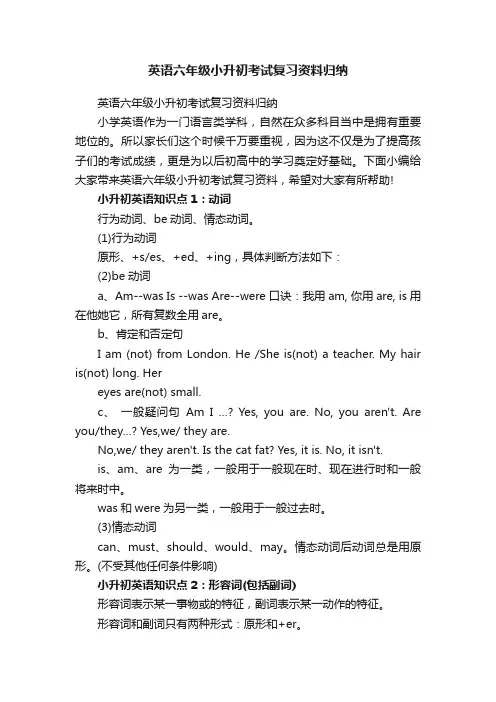
英语六年级小升初考试复习资料归纳英语六年级小升初考试复习资料归纳小学英语作为一门语言类学科,自然在众多科目当中是拥有重要地位的。
所以家长们这个时候千万要重视,因为这不仅是为了提高孩子们的考试成绩,更是为以后初高中的学习奠定好基础。
下面小编给大家带来英语六年级小升初考试复习资料,希望对大家有所帮助!小升初英语知识点1:动词行为动词、be动词、情态动词。
(1)行为动词原形、+s/es、+ed、+ing,具体判断方法如下:(2)be动词a、Am--was Is --was Are--were 口诀:我用am, 你用are, is用在他她它,所有复数全用are。
b、肯定和否定句I am (not) from London. He /She is(not) a teacher. My hair is(not) long. Hereyes are(not) small.c、一般疑问句Am I …? Yes, you are. No, you aren't. Are you/they…? Yes,we/ they are.No,we/ they aren't. Is the cat fat? Yes, it is. No, it isn't.is、am、are为一类,一般用于一般现在时、现在进行时和一般将来时中。
was和were为另一类,一般用于一般过去时。
(3)情态动词can、must、should、would、may。
情态动词后动词总是用原形。
(不受其他任何条件影响)小升初英语知识点2:形容词(包括副词)形容词表示某一事物或的特征,副词表示某一动作的特征。
形容词和副词只有两种形式:原形和+er。
未作比较的情况下就用原形,比较时就+er。
两个重要特征:as……as中间一定用原形,有than的时候一定+er。
小升初英语知识点3:人称代词和物主代词人称代词物主代词单数复数单数复数主格宾格主格宾格形容词性(短)名词性(长)形容词性(短)名词性(长) 第一人称Imeweusmymineourours第二人称youyouyouyouyouryoursyouryours第三人称hehimtheythemhishistheirtheirssheherherhersitititsits人称代词:有主格和宾格之分。
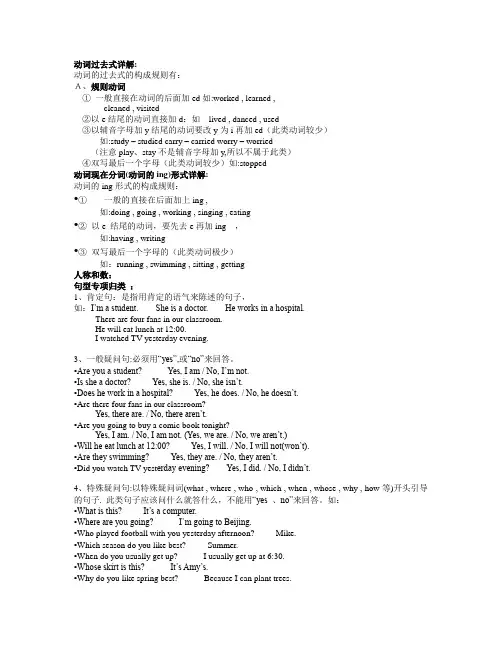
动词过去式详解:动词的过去式的构成规则有:A、规则动词①一般直接在动词的后面加ed如:worked , learned ,cleaned , visited②以e结尾的动词直接加d:如lived , danced , used③以辅音字母加y结尾的动词要改y为i再加ed(此类动词较少)如:study – studied carry – carried worry – worried(注意play、stay不是辅音字母加y,所以不属于此类)④双写最后一个字母(此类动词较少)如:stopped动词现在分词(动词的ing)形式详解:动词的ing形式的构成规则:•①一般的直接在后面加上ing ,如:doing , going , working , singing , eating•②以e 结尾的动词,要先去e再加ing,如:having , writing•③双写最后一个字母的(此类动词极少)如:running , swimming , sitting , getting人称和数:句型专项归类:1、肯定句:是指用肯定的语气来陈述的句子,如:I’m a student. She is a doctor. He works in a hospital.There are four fans in our classroom.He will eat lunch at 12:00.I watched TV yesterday evening.3、一般疑问句:必须用“yes”,或“no”来回答。
•Are you a student? Yes, I am / No, I’m not.•Is she a doctor? Yes, she is. / No, she isn’t.•Does he work in a hospital? Yes, he does. / No, he doesn’t.•Are there four fans in our classroom?Yes, there are. / No, there aren’t.•Are you going to buy a comic book tonight?Yes, I am. / No, I am not. (Yes, we are. / No, we aren’t.)•Will he eat lunch at 12:00? Yes, I will. / No, I will not(won’t).•Are they swimming? Yes, they are. / No, they aren’t.•Did you watch TV yest erday evening? Yes, I did. / No, I didn’t.4、特殊疑问句:以特殊疑问词(what , where , who , which , when , whose , why , how等)开头引导的句子. 此类句子应该问什么就答什么,不能用“yes 、no”来回答。
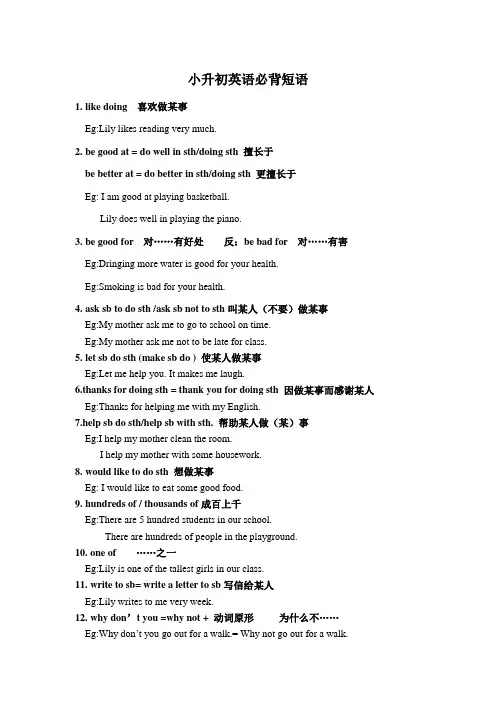
小升初英语必背短语1.like doing 喜欢做某事Eg:Lily likes reading very much.2.be good at = do well in sth/doing sth 擅长于be better at = do better in sth/doing sth 更擅长于Eg: I am good at playing basketball.Lily does well in playing the piano.3.be good for 对……有好处反:be bad for 对……有害Eg:Dringing more water is good for your health.Eg:Smoking is bad for your health.4.ask sb to do sth /ask sb not to sth叫某人(不要)做某事Eg:My mother ask me to go to school on time.Eg:My mother ask me not to be late for class.5.let sb do sth (make sb do ) 使某人做某事Eg:Let me help you. It makes me laugh.6.thanks for doing sth = thank you for doing sth 因做某事而感谢某人Eg:Thanks for helping me with my English.7.help sb do sth/help sb with sth. 帮助某人做(某)事Eg:I help my mother clean the room.I help my mother with some housework.8.would like to do sth 想做某事Eg: I would like to eat some good food.9.hundreds of / thousands of成百上千Eg:There are 5 hundred students in our school.There are hundreds of people in the playground.10.one of ……之一Eg:Lily is one of the tallest girls in our class.11.write to sb= write a letter to sb写信给某人Eg:Lily writes to me very week.12.why don’t you =why not + 动词原形为什么不……Eg:Why don’t you go out for a walk.= Why not go out for a walk.13.something important 一些重要的事情不定代词+形容词14.it’s time to do sth= it’s time for sth.是时候做某事了Eg:It’s time to have lunch.= It’s time for lunch.15.be like问性格,look like 问外貌be like 范围更大一些,有时候既问性格也问外貌Eg:What's your sister like? 你姐姐怎么样?/你姐姐是怎样一个人?She is kind. 她很善良。
六年级小升初必考知识点英语英语是小升初考试的重要科目之一,掌握好必考知识点对于考试取得好成绩至关重要。
本文将为大家介绍六年级小升初英语中的必考知识点,希望能帮助同学们更好地备考。
一、词汇1. 数词:掌握基础的数字表达,包括个位数、十位数、百位数等。
2. 颜色:熟悉常用颜色的英语表达方式,如红色(red)、蓝色(blue)、黄色(yellow)等。
3. 季节:掌握四季的英语表达,如春天(spring)、夏天(summer)、秋天(autumn)、冬天(winter)等。
4. 动物:熟悉常见动物的英语表达,如狗(dog)、猫(cat)、鸟(bird)、鱼(fish)等。
5. 食物:掌握基本的食物名称,如苹果(apple)、香蕉(banana)、面包(bread)、牛奶(milk)等。
二、基础语法1. 名词复数形式:了解名词复数的变化规则,如一般情况下在名词后加-s,以辅音字母+y结尾的名词变-y为-i再加-es,以o结尾的名词变-o为-es等。
2. 人称代词:掌握I、you、he、she、it等人称代词的用法,以及与动词的配合形式。
3. 简单句和否定句:了解简单句的基本结构,即主语+谓语动词+宾语,并学会构建否定句,即在谓语动词前加上"don't"或"doesn't"。
4. 一般过去时:了解一般过去时的构成规则,即对于大多数动词在动词原形后加-ed,对于以字母e结尾的动词直接添加-d。
同时注意一些不规则动词的过去形式变化。
三、常见句型1. What's your name?(你叫什么名字?) - My name is...2. How old are you?(你多大了?)- I am...years old.3. What's this?(这是什么?)- This is a...4. Do you like...?(你喜欢...吗?)- Yes, I do. / No, I don't.五、常见对话1. 问候和自我介绍A: Hello, what's your name?B: Hi, my name is Lily.2. 询问年龄A: How old are you?B: I'm ten years old.3. 询问喜好A: Do you like English?B: Yes, I do. / No, I don't.4. 询问家庭成员A: How many people are there in your family?B: There are four people in my family.以上是六年级小升初英语必考知识点的介绍,希望能帮助同学们在备考中有所收获。
小学六年级小升初考试英语知识点总结小学六年级小升初考试英语知识点总结小学六年级的学生将要参加小升初考试,做好英语知识点总结,有利于考生在考试中获得一个好成绩。
店铺为大家力荐了小学六年级小升初英语知识点,给大家作为参考,欢迎阅读!小学六年级小升初英语基础知识点服装:服装的颜色:人对服装的喜好;某人的穿戴; 所属关系clothes: hat, cap, coat, shirt , T-shirt, skirt, dress, sweater, jacket, trousers, sock, shoe put on, wear所属关系: 形容词性的物主代词:my, your, his, her, its, our, their 名词性的物主代词: mine, yours, his, hers, its, ours, theirs相关句型:1) What does it look like? It likes wearing a blue shirt.2) Whose shoes are these? They’re mine. They’re Tom’s .3) Is this /that/it your book? Yes, it is. No, it isn’t.4) Is this pencil yours? Yes, it is. No, it isn’t.5) Are these /those/they your coats and trousers? Yes, they are. No, they aren’t.6) Are tho se clothes theirs? Yes, they are. No, they aren’t.7) This is my hat. That hat is his.玩具和文具:特点、颜色、所属关系;存在的`位置Toys: doll, toy…文具: desk, book, bag ,pen, pencil, pencil-box, ruler, chair, ball 存在的位置 : in, on, under, beside, behind, in front of, in the front of , in the middle of, at the back of…(a place/a person).相关句型:1) There is a cup of tea on the table.2) There are some oranges in the fridge.3) Is there any milk in the glass? Yes, there is. No, there isn’t.4) Are there any oranges in the fridges? Yes, there are. No, there aren’t.5) What’s under the desk?There is an orange. / There are some oranges.小学六年级小升初英语重要知识点形容词的比较级和最高级1、单音节词:比较级加er,最高级加est。
小升初英语必考知识点汇总:小升初英文必背知识点汇总40条1.现在进行时表示正在发生的事情或进行的动作,常与now,listen,look等词连用,结构是主语+be动词(am,is,are)+动词ing.如:It is raining now.It is six o’clock now.My parents are reading newspapers in the sitting room. Look!The children are having a running race now.Listen!Who is singing in the music room.问句将be动词移前,否定句在be动词后+not.2.一般现在时表示经常反复发生的事情或动作,常与often,usually,sometimes, always,every day(week year…)on Sundays等词连用。
结构是主语+动词原形;当主语为第三人称单数即he,she,it,Tom,my mother,the boy等词时,动词后加s或es.如:We have an English lesson every day.My brother often catches insects at the weekends.Do the boys run faster than the girls?Yes,they do.Ben doesn’t do well in PE.问句借助于do,does否定句借助于don’t,doesn’t,后面动词一定要还原。
3.一般过去时表示发生在过去的事情或存在的状态,常与just now;a moment ago;…ago;yesterday;last(week;month;year;Monday;weekend);this morning等词连用,结构是主语+be动词的过去式(was;were)或主语+动词的过去式。
最新人教版小升初英语必考知识点总结最新人教版小升初英语必考知识点总结一、动词时态1、一般现在时:主语+动词原形+其他;表示习惯性、经常性的动作或状态。
例:I usually get up at 7 o'clock every morning.2、现在进行时:主语+be+动词ing+其他;表示正在进行的动作或状态。
例:He is playing basketball now.3、一般将来时:主语+will+动词原形+其他;表示将来要发生的动作或状态。
例:She will visit her grandparents next weekend.二、名词1、单数名词:指只有一个单词的名词,如cat, dog等。
2、复数名词:指有两个或以上单词组成的名词,如cats, dogs等。
三、冠词1、不定冠词a/an:用于可数名词单数前,表示泛指或数量“一”。
例:There is an orange on the table.2、定冠词the:用于可数名词复数前,表示特指或上文提到的某个事物。
例:The cats are playing in the garden.四、代词1、人称代词:指用来代替人的代词,如I, you, he等。
2、物主代词:指用来表示物品所属关系的代词,如my, your, his 等。
五、形容词和副词1、形容词:用来修饰名词,表示名词的性质或状态,如beautiful, happy等。
2、副词:用来修饰动词、形容词或其他副词,表示动作的方式或程度,如quickly, carefully等。
六、介词1、表示时间的介词:in表示在某个时间范围之内,on表示在某一天或具体某一天的上午或下午,at表示在某一具体时间点。
例:I will arrive at the airport at 10 o'clock.2、表示地点的介词:in表示在某个地方范围之内,on表示在某物表面上,at表示在某个具体地点。
六年级小升初英语知识点|英语小升初必考知识点小升初的英语知识点,你都掌握了吗?下面WTT给你分享六年级小升初英语知识点,欢迎阅读。
六年级小升初英语知识点(一)学生易错词汇1.a,an的选择: 元音字母开头的单词用an,辅音字母开头的单词用a.2 am , is , are的选择: 单数用is , 复数用are.I用 am , you 用 are.3 have , has 的选择: 表示某人有某物。
单数用has , 复数用have.I,you 用 have .4.thereis, there are 的选择:表示某地有某物,某人。
单数用there is , 复数用there are.5.some,any 的选择:肯定句用some, 疑问句和否定句用any.6.疑问词的选择:what(什么) who (谁) where (哪里) whose (谁的) why(为什么)when(什么时候)which(哪一个)how old (多大) how many (多少)how much(多少钱)六年级小升初英语知识点(二)动词过去式详解动词的过去式的构成规则有:A、规则动词①一般直接在动词的后面加ed如worked,learned , cleaned , visited②以e结尾的动词直接加d如lived , danced , used③以辅音字母加y结尾的动词要改y为i再加ed(此类动词较少)如study – studied carry – carried worry– worried (play、stay)④双写最后一个字母(此类动词较少)如stoppedB、不规则动词(此类词并无规则,须熟记)小学阶段要记住以下动词的原形和过去式:sing– sang , eat – ate , see – saw , have – had , do – did , go – went ,take – took , buy – bought , get – got , read – read ,fly – flew , am/is – was ,are – were , say – said , leave – left , swim – swam , tell – told , draw– drew , e – came , lose – lost , find – found , drink – drank , hurt – hurt , feel – felt六年级小升初英语知识点(三)形容词比较级详解当我们需要对事物作出比较时,需要用到比较级。
人教版小升初英语基础知识点整理汇总
以下是人教版小升初英语基础知识点的整理汇总:
1. 单词拼写
- 掌握常用的基础单词的拼写,包括名词、动词、形容词等。
- 注意单词的大小写和词形变化。
2. 语法知识
- 理解基本的句子结构,包括主语、谓语、宾语等。
- 研究使用一般现在时、一般过去时和一般将来时等基本时态。
- 了解常用的代词、冠词、介词等语法要点。
3. 句型构造
- 学会构造简单句、复合句和疑问句等不同句型。
- 熟练掌握肯定句、否定句和疑问句的构造方法。
4. 阅读理解
- 提高阅读理解能力,理解文章中的主题、细节和推理等内容。
- 掌握常用的阅读策略,如扫读、略读和细读。
5. 口语表达
- 练口语对话,培养流利的英语口语表达能力。
- 研究常用的口语交际用语,如问候、感谢和道歉等。
6. 写作能力
- 学会日常生活场景中的简单写作表达,如介绍自己、描述活动等。
- 注意语法和拼写错误,并尝试运用多样的句型和词汇。
以上是人教版小升初英语基础知识点的整理汇总,希望对你的学习有所帮助。
如果还有其他问题,请随时向我提问。
小升初英语必考知识点汇总:小升初英文必背知识点汇总40条1.现在进行时表示正在发生的事情或进行的动作,常与now,listen,look等词连用,结构是主语+be动词(am, is, are)+动词ing.如:It is raining now.It is six o’clock now. My parents are reading newspapers in the sitting room. Look! The children are having a running race now.Listen! Who is singing in the music room.问句将be动词移前,否定句在be动词后+not.2. 一般现在时表示经常反复发生的事情或动作,常与often, usually, sometimes, always, every day(week year…) on Sundays等词连用。
结构是主语+动词原形;当主语为第三人称单数即he,she, it, Tom, my mother, the boy等词时,动词后加s或es.如:We have an English lesson every day.My brother often catches insects at the weekends.Do the boys run faster than the girls? Yes, they do.Ben doesn’t do well in PE.问句借助于do, does否定句借助于don’t,doesn’t,后面动词一定要还原。
3. 一般过去时表示发生在过去的事情或存在的状态,常与just now; a moment ago; … ago; yesterday; last ( week; month; year; Monday; weekend); this morning等词连用,结构是主语+be动词的过去式(was; were)或主语+动词的过去式。
注意:be动词与动词过去式不可同时使用。
如:My earphones were on the ground just now.Where were you last week? I was at a camp.What did you do yesterday? I visited a farm问句有be动词将be动词移前,没有be动词借助于did,后面动词还原;否定句有be动词在后面加not,没有借助于didn't后面动词还原。
4. 一般将来时表示将要打算发生的事情或动作,常与tomorrow, next week(year; Tuesday…), this week( weekend ;evening; afternoon;…)today等词连用。
结构是主语+be(am, is, are) going to + 动原或主语+will +动原。
如:What are you going to do tomorrow? I am going to have a picnic.My sister is going to play the piano at the concert.The children are going to have a sports meeting next week.Tom will/is going to see a play with his father this evening.问句将be动词或will移前;否定句在be动词或will后加not.5. 情态动词can; can’t; should; shouldn’t; must; may后一定加动词原形。
如:The girl can’t swim, but he can skate.Don’t talk in class, you should listen to the teacher carefully.6. 肯定祈使句以动词原形开头;否定祈使句以don’t加动词原形开头。
如:Open the box for me ,please.请为我打开盒子。
Liu Tao! Please get up earlier tomorrow.涛,明天请早点起床!Don’t walk on the grass!不要在草地上走!Helen! Don’tclimb the tree,please.海伦!不要爬树。
7. 去干嘛用go +动词ing 如: go swimming; go fishing; go skating; go camping; go running; go skiing; go rowing…8.than 前用比较级;as…as之间用原级。
如:My mother is two years younger than my father.我妈比我爸年轻两岁。
Liu Tao jumps as far as Ben.涛跳得和本一样远。
9. 喜欢做某事用like +动词ing或like+ to + 动原。
如: Su Yang likes growing flowers.阳喜欢种花。
The children like toplay with lanterns at Spring Festival.孩子们喜欢在春节去玩花灯。
10. 想要做某事用 would like +to+动原或want + to +动原。
I’d like to visit the History Museum.=I want to visit the History Museum.11. some 用于肯定句中,在否定句和问句中改为any,但当表示委婉语气时仍用如:Can I have some writing paper? Would you like some orange juice?12.人称代词主格做主语用,一般放在句首或动词前,主格分别是 I you he she it we you they。
宾格做宾语用,一般放在动词或介词后如:Open them for me.Let us …, join me等。
宾格分别是me you him her it usyou them。
形容词性物主代词放在名词前,不能单独使用,分别是my your his her its our your their。
名词性物主代词相当于形物加名词,它只能单独使用后面不好加名词,分别是mine yours his hers its ours yours theirs。
13. 介词后要么不加动词,加动词只能加动词ing形式,如:be good at running; do well in jumping;14. 季节前,月份前用介词in,如:in summer;in March,具体的哪一天如星期几,几月几日用介词on如:on Saturday; on the second of April; on Wednesdaymorning,在几点钟前用介词at如: at a quarter to four; 只在上下午晚上用in 如:in the morning/ afternoon/ evening; 但在夜间用at night。
另:季节,月份和星期前不好加the.15. 名词复数构成的方法有规则的有(1)直接在名词后加s如orange—oranges; photo—photos;(2) 以x, s, sh, ch 结尾的加es如:box—boxes; glass—glasses; waitress —waitresses;watch—watches;peach--peaches(3) 以辅音字母加y结尾的改y为i加es如:study—studies;library—libraries; hobby—hobbies; family—families;(4)以f, fe结尾的改f, fe 为v+es如:knife—knives; thief—thieves(注:以o结尾的我们学过的只有mango加es, mango—mangoes其余加s,)不规则的有:man—men; woman—women; people—people; child—children16. 动词第三人称单数的构成(1)直接在动词后加s如:run—runs;dance—dances(2)以s,sh,ch,o结尾的加es如:do—does;go—goes;wash—washes;catch —catches (3)以辅音字母加y结尾的改y为i加es如:study—studies; carry—carries;17. 现在分词的构成(1)直接在动词后加ing如:sing—singing;ski—skiing;(2)双写词尾加ing如:swim—swimming;jog—jogging;run—running;(3)以不发音的e结尾的去e加ing如:ride—riding; dance —dancing; make—making;18. 规则动词过去式的构成(1)直接在动词后加ed,如:clean—cleaned; milk—milked; play—played;(2)以e结尾的直接加d如:dance—danced; taste—tasted;(3) 以辅音字母加y结尾的改y为i加ed如:study—studied;carry—carried;(4)双写词尾加ed如:stop—stopped; jog—jogged;不规则的有am,is—was; are—were; do,does—did; have,has—had; go—went; meet—met; sit—sat; see—saw; get—got; tell—told; run—ran; come—came; steal—stole; read—read;19.形容词副词比较级的构成规则的(1)直接在形容词或副词后加er如;small—smaller; low—lower;(2)以e结尾的加r如:late—larer;(3)双写词尾加er 如:big—bigger; thin —thinner; fat—fatter;(4) 以辅音字母加y结尾的改y为i加er如:heavy—heavier; early—earlier;不规则的有:good, well—better(最高级为best); many, much--- more(最高级为most); far---farther;20.rain与snow的用法(1)作为名词意思是雨水和雪是不可数名词如:There is a lot of rain there in spring. 那儿的春天有很多雨水。